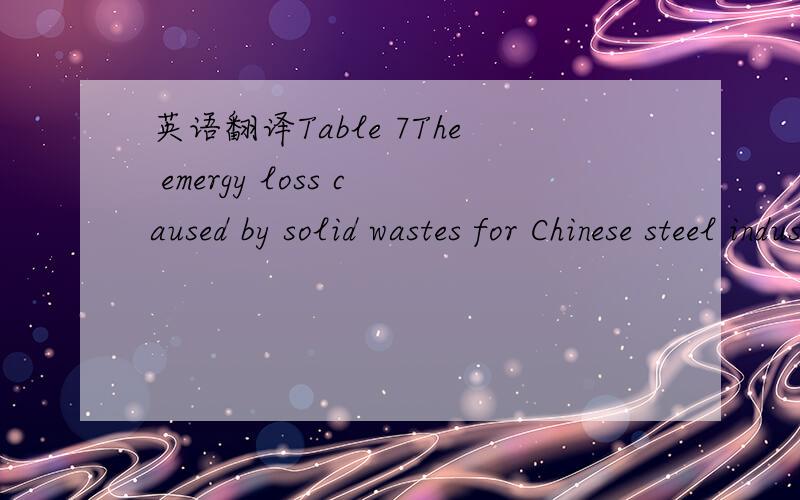英语翻译Table 7The emergy loss caused by solid wastes for Chinese steel industry in 1998–2004(unit/a).impacts on the production process are generally reduced even though the steel output is continuously increasing.(3) Product transformity:PT is
来源:学生作业帮助网 编辑:作业帮 时间:2024/11/29 23:23:00

英语翻译Table 7The emergy loss caused by solid wastes for Chinese steel industry in 1998–2004(unit/a).impacts on the production process are generally reduced even though the steel output is continuously increasing.(3) Product transformity:PT is
英语翻译
Table 7
The emergy loss caused by solid wastes for Chinese steel industry in 1998–2004(unit/a).impacts on the production process are generally reduced even though the steel output is continuously increasing.
(3) Product transformity:PT is generally decreased in this period although it shows slight fluctuation after 2001.After 2001,steel transformity is close to that of U.S.A in 1995 and 1998 (4.10E21 seJ/Mt in 1995 [76]; 4.13E21 seJ/Mt in 1998 [77]),Sweden in 2002 (4.13E21 seJ/Mt [78]),and Brazil in 2006 (4.13E21 seJ/Mt [79]); however,it is still higher than that of Spain in 2000 (3.69E21 seJ/Mt [80]),even higher than Mexico in 1989 (1.8E21 seJ/Mt [81]),but lower than U.S.A in 2003 (6.97E21 seJ/Mt [30]),and Nicaragua in 2005 (1.13E22 seJ/Mt [82]).Therefore,steel production of China is generally enhancing its production efficiency in this period.
(4) eMergy yield ratio:EYR is fluctuating between 2.00 and 3.40.The economic benefit of Chinese steel production is generally moderate,but slightly reduced in this period.
(5) eMergy investment ratio:EIR is generally increasing in this period although it fluctuates in some years,and this shows that Chinese steel production has more dependence on the purchased inputs with its output increasing.This case is validated by Ref.[44],the amount of iron ore Chinese steel industry imported was increased to 208 Mt in 2004 from 70 Mt in 2000,imported manganese ore was increased to 465 t in 2004 from 120 t in 2000,and chrome ore completely depended on importation in 2000–2004.
(6) Environmental loading ratio:ELR is fluctuating between 43 and 61 if ignoring emissions’ impacts,while the value will be increased by 29–42% ([ELR(new) ELR(old)]/ELR(old)) if considering these impacts.The environmental stress is generally increasing although it fluctuates in some years.Therefore,Chinese steel production has great environmental stress (theELR >10),and emissions’ impacts on environmental loading are obvious.
(7) Renergy/Nenergy:it is fluctuating between 2.50% and 5.60%,which means that 94.40–97.50% of the total energy inputs come from nonrenewable energy; meanwhile,fraction of renewable energy inputs has been slightly decreased after 1999.This case may lead to the increasing environmental loading.
(8) N/(F2 þR3 þ R2):the ratio is decreasing,which shows that more nonrenewable resources have become into emissions with the development of Chinese steel industry because emissions come from nonrenewable resources consumption.This case reflects that the efficiency of nonrenewable resources is generally
decreasing in this period.Many small and medium steel plants should be responsible for this because of their outdated technologies and poor infrastructures [47].
英语翻译Table 7The emergy loss caused by solid wastes for Chinese steel industry in 1998–2004(unit/a).impacts on the production process are generally reduced even though the steel output is continuously increasing.(3) Product transformity:PT is
表7
造成损失的能值,固体废物对中国钢铁行业在1998-2004年(单位 /年).影响对生产过程中,即使普遍减少钢产量不断增加.
(3)产品转换率:PT是普遍下降,虽然在这期间它显示了在2001年后略有波动.2001年后,钢材转换率接近於美国在1995年和1998年(4.10E21 seJ /山於 1995年[76]; 4.13E21 seJ /万吨,到1998年[77]),瑞典於 2002年(4.13E21 seJ /山[78 ]),和巴西在2006年(4.13E21 seJ /山[79]),但它仍然高於 2000年的西班牙(3.69E21 seJ /山[80]),甚至高於墨西哥在1989年(1.8E21 seJ /山[81]),但低於美国 2003年(6.97E21 seJ /山[30]),和尼加拉瓜在2005年(1.13E22 seJ /山[82]).因此,中国钢铁产量的普遍提高其生产效率在这一时期.
(4)能值产出率:EYR是2.00和3.40.The之间波动经济效益中钢产量是适度的,但在此期间略有减少.
(5)能值投资比例:设备交接单是在这期间普遍增加它的波动,虽然在某些年份,这说明中国钢铁产量有更多的依赖於所购买的投入,其产量增加.这一案例验证了号.[44],其数额铁矿石中国钢铁行业进口增加至208万吨,到2004年,从 2000年的70万吨,锰矿进口增加至465 t在2004年120吨於 2000年,铬矿完全依赖进口的2000-2004年.
(6)环境负荷率:式ELR是43和61之间波动,如果无视排放量'的影响,而该值将增加29-42%([式ELR(新)式ELR(旧)] /式ELR(旧))如果考虑这些影响.环境压力普遍提高,虽然它在某些年份的波动.因此,中国钢产量有很大的环境压力(theELR“10),和排放,对环境负荷的影响是显而易见的.
(7)Renergy / Nenergy:它是2.50%之间波动和5.60%,这意味著 94.40-97.50%的总能量输入来自不可再生的能源,同时,部分可再生能源的投入已在1999年后略有下降.这种情况下可能导致日益严重的环境负荷.
(8)无 /(F2键 þR3 þ右二):这个比例正在下降,这表明更多的不可再生资源已成为进入排放量的发展,因为中国的钢铁工业排放来自於不可再生资源的消耗.这种情况反映的效率一般是不可再生资源
在此期间下降.许多中小型钢铁厂应该负责,因为他们过时的技术和基础设施较差 [47].
表7
能值固体废物造成的损失在1998-2004年(单位/年)。在生产过程中影响是,即使普遍减少钢产量不断增加对中国钢铁行业。
(3)产品转换率:PT是普遍下降,虽然在这期间它显示了2001年以后略有波动。 2001年后,钢材转换率接近美国,1995年和1998年(4.10E21 seJ /山于1995年[76]; 4.13E21 seJ / 1998 [77]吨),瑞典于2002...
全部展开
表7
能值固体废物造成的损失在1998-2004年(单位/年)。在生产过程中影响是,即使普遍减少钢产量不断增加对中国钢铁行业。
(3)产品转换率:PT是普遍下降,虽然在这期间它显示了2001年以后略有波动。 2001年后,钢材转换率接近美国,1995年和1998年(4.10E21 seJ /山于1995年[76]; 4.13E21 seJ / 1998 [77]吨),瑞典于2002年(4.13E21 seJ /山[78 ]),和巴西在2006年(4.13E21 seJ /山[79]),但它仍然比西班牙高出2000年(3.69E21 seJ /山[80]),甚至比墨西哥高于1989年(1.8E21 seJ /山[81]),但比美国低2003(6.97E21 seJ /山[30]),和尼加拉瓜在2005年(1.13E22 seJ /山[82])。因此,中国钢铁生产在此期间普遍提高生产效率。
(4)能值产出率:EYR介于2.00和3.40.The的中国钢铁生产的经济利益波动是适度的,但在此期间略有减少。
(5)能值投资比例:设备交接单是这一时期普遍增加,尽管它在某些年份波动,这表明,中国钢铁产量有更多关于其产量增加了购买的投入的依赖。这一案例验证了号。 [44],铁矿石的中国钢铁行业进口量增加至208万吨,到2004年,2000年70万吨,锰矿进口增加至465 t在2004年120吨,2000年和铬矿石完全依赖进口的2000-2004年。
(6)环境负荷率:式ELR是43和61之间波动,如果无视排放量'的影响,而值会增加29-42%([式ELR(新)式ELR(旧)] /式ELR(旧))如果考虑这些影响。环境压力普遍提高,虽然它在某些年份波动。因此,中国钢产量有很大的环境压力(theELR“10),以及环境负荷排放量'的影响是显而易见的。
(7)Renergy / Nenergy:它介于2.50%和5.60%,这意味着94.40-97.50的总能量不可再生的能源来投入%波动,同时,可再生能源的投入比例在1999年后已略有下降。这种情况下可能导致日益严重的环境负荷。
(8)无/(F2键þR3 þ右二):这个比例正在下降,这表明更多的不可再生资源是随中国钢铁工业的发展,因为排放的废气成为不可再生的资源消耗来。这个案例反映了不可再生资源的效率一般
在此期间下降。许多中小型钢铁厂应由于其过时的技术基础设施差这个责任[47]。
收起